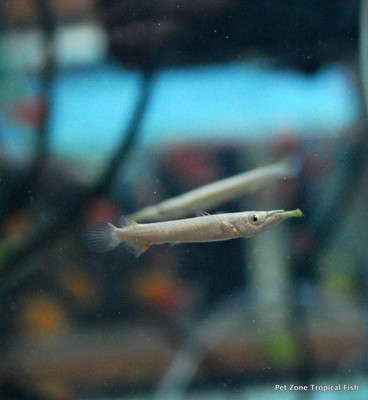Wrestling Halfbeak
Posted by Max Gandara on on 14th May 2025
Wrestling Halfbeak: The Surface-Dwelling Duelist of Freshwater Tanks
Among the many curious species that find their way into freshwater aquariums, the Wrestling Halfbeak stands out for its slender body, quirky mouth, and fascinating behavior. Also known as the Malayan Halfbeak, this small surface-dweller is best known for its unusual jaw structure and its habit of "wrestling" with rivals—hence the name.
Let’s explore what makes the Wrestling Halfbeak (Dermogenys pusilla) such an intriguing species for aquarists who love something a little different.
What is a Wrestling Halfbeak?
The Wrestling Halfbeak is a livebearing fish native to the calm, slow-moving waters of Southeast Asia, especially in Thailand, Malaysia, and Indonesia. It typically grows to 2.5–3 inches (6–7.5 cm) and is easily recognized by its elongated lower jaw, which gives the appearance of a “half-beak.”
Males are more slender and possess a modified anal fin called a gonopodium, while females tend to be fuller-bodied.
Natural Habitat and Behavior
In the wild, Wrestling Halfbeaks inhabit shallow streams, swamps, and estuaries, usually staying close to the water’s surface. They are named for the ritualized sparring matches that males engage in to establish dominance—these wrestling bouts are usually harmless and more about posturing than actual fighting.
Despite their confrontational name, they’re peaceful with most other species, but males can be aggressive toward one another, especially in smaller tanks.
Aquarium Care
Wrestling Halfbeaks are not as common as guppies or tetras, but they're relatively easy to keep once their needs are understood.
Tank Requirements
-
Tank size: Minimum 15–20 gallons (larger if keeping multiple males)
-
Water temperature: 75–82°F (24–28°C)
-
pH level: 7.0–8.0 (they prefer slightly alkaline water)
-
Hardness: Moderate to hard
-
Substrate: Doesn’t matter much—they live at the surface
They are surface dwellers, so your tank should have a secure lid—these fish are skilled jumpers and may leap out if startled.
Diet
In the wild, Wrestling Halfbeaks feed on small insects and larvae. In captivity, they’ll accept:
-
Live or frozen foods: mosquito larvae, daphnia, brine shrimp
-
Floating micro-pellets or flakes
-
Avoid sinking foods, as they rarely leave the surface to forage
A high-protein diet helps keep them healthy and supports breeding.
Breeding
Like guppies and mollies, Wrestling Halfbeaks are livebearers. Breeding them isn’t difficult, but raising the fry requires care.
-
Gestation period: ~4 weeks
-
Number of fry: 10–40 per batch
-
Adults may eat fry, so a breeding trap or heavily planted area is recommended
Interestingly, the male's gonopodium is used to inseminate the female, much like other livebearers.
Tankmates
Wrestling Halfbeaks do best with peaceful, non-aggressive species that occupy the mid to lower water levels, such as:
-
Corydoras catfish
-
Small rasboras
-
Dwarf gouramis
-
Tetras (non-nippy varieties)
Avoid fin-nippers or overly active species, as these can stress halfbeaks or injure their delicate jaws.
Why Keep Wrestling Halfbeaks?
If you’re looking for a unique surface-dwelling fish with interesting behavior and an elegant, streamlined look, the Wrestling Halfbeak is a fantastic addition. They’re relatively hardy, visually distinctive, and provide endless fascination with their “jousting” rituals and surface-skimming lifestyle.
Just be sure to provide the right conditions—and a tight lid!

